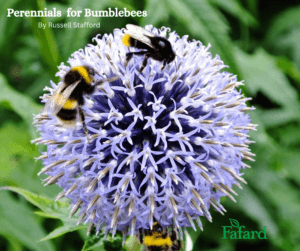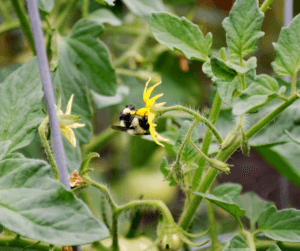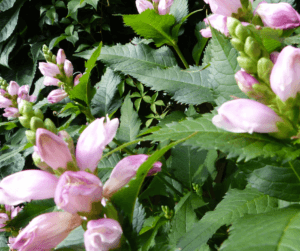
Who doesn’t love bumblebees (other than the occasional apiophobe)? These colorful, fuzzy, aerodynamically challenged hymenopterans charm and delight us as they bumble from bloom to bloom.
They also provide first-rate pollination services. In most situations, bumblebees are far more efficient pollinators than those exotic interlopers, honeybees. Some plant species practically require bumblebees to get the pollination job done – otherwise they bear fewer fruits, or none at all. A classic example are members of the nightshade family (the Solanaceae), including tomatoes, eggplants, bell peppers, and numerous other prized edibles. Locked deep in their anthers, their pollen requires a good shaking to be released. As it so happens, bumblebees are masters of a technique that does just that – buzz pollination. Consequently, bumblers are an essential resource for anyone trying to produce a solanaceous crop. Watch and listen as bumblebees visit your tomato plants, and you’ll see and hear what the buzz is about. Also undergoing buzz pollination are members of the heath family (Ericaceae), including blueberries, rhododendrons, and mountain laurels.

Even plants that don’t require buzz pollination reproduce more successfully when bumblebees are part of the pollination mix. For example, the fertility of the eastern and central U.S. native tall bellflower (Campanula americana) drops significantly when bumblebees aren’t present. Bumblers’ large, fuzzy bodies provide lots of carrying capacity, ideal for delivering generous payloads of sticky pollen from one flower to the next.
Bumblebees are thus not merely a joy to behold. They’re also vital to the health of local native plant communities. These are both excellent reasons to invite them into your garden – particularly given that many of the 40-plus North American bumblebee species are dwindling in the wild.
Many garden-worthy wildflowers in addition to those discussed above are big bumblebee faves.
Goldenrods (Solidago spp., aka Oligoneuron)
Europeans have long valued these glorious, mainly North American perennials, but goldenrods still get short shrift in American gardens. Wherever they occur, they’re a staple of bumblebees’ late-summer diet, as well as one of the main nectar sources for southbound monarch butterflies. Some spread invasively underground, but many form well-behaved clumps surmounted by showy flower clusters, typically of the tribe’s signature gold hue. And no, they don’t cause hay fever. Among the best for the garden are stiff goldenrod (Solidago rigida), showy goldenrod (Solidago speciosa), and Ohio goldenrod (Solidago ohiensis), which all top out at more than 3 feet tall. For something different, try one of the atypical white-flowered species such as silverrod (Solidago bicolor). Silverrod also distinguishes itself by doing well in shade, unlike most other goldenrods (bluestem goldenrod – Solidago caesia – and zigzag goldenrod – S. flexicaulis – are two other notable shade-lovers).

Beardtongues (Penstemon spp.)
Blooming in late spring and early summer, eastern- and central-U.S. species of this exclusively American genus tend to be white or purplish in flower color. The asymmetrically two-lipped blooms
are irresistible to bumblebees and hummingbirds, whatever the color. Foxglove beardtongue (Penstemon digitalis) features spikes of white flowers on 3-foot stems, as does the showiest of the white-flowered species, prairie beardtongue (Penstemon tubaeflorus). Purple-leaved forms and hybrids of foxglove beardtongue such as ‘Husker Red’ and ‘’Dark Towers’ tend to bloom in shades of lilac. So, too, do hairy beardtongue (Penstemon hirsutus) and the especially showy Blue Ridge beardtongue (Penstemon smallii), both 24 to 30 inches tall. Western U.S. Penstemon species come in a much wider range of colors, but often fail in Eastern climes.
Joe-Pye weeds (Eupatorium ssp., aka Eutrochium)
The large fuzzy flowerheads of these typically imposing perennials are a banquet for the eyes and the bumblebees. Most – including spotted and costal Joe-Pye weed (Eupatorium maculatum and E. dubium), bear purplish pink flowers at about the same time as goldenrods, above several-foot-tall phalanxes of coarse-leaved stems. Hyssop-leaved Joe-Pye weed (Eupatorium hyssopifolium) is a charming oddball, producing white flowers on relatively compact, narrow-leaved clumps.
Asters (Aster spp., aka Symphyotrichum)
Dozens of aster species are suitable for the garden, with fragrant aster (Aster oblongifolius), showy aster (Aster spectabilis), and New England aster (Aster novae-angliae) numbering among the best and most widely available of the larger species (3-feet-tall or more). Numerous lower-growing species also make excellent garden subjects. Fine-textured, needle-like leaves are a feature of several of them, such as dwarf forms of heath aster (Aster ericoides) and calico aster (Aster lateriflorus). Both are useful groundcovers for hot sunny sites. Short’s aster (Aster shortii), bigleaf aster (Aster macrophyllus), and heartleaf aster (Aster cordifolius) are among the best of the bunch for shade. Incidentally, the genus gives its name to the composite family (Asteraceae), which encompasses many other bumblebee-friendly tribes including blazing-stars (Liatris spp.), ironweeds (Vernonia spp.) and the aforementioned Joe-Pye weeds and goldenrods.

Lobelias (Lobelia spp.)
All the above genera comprise mostly sun-loving plants. Lobelias are among the best native perennials for shade. Cardinal flower (Lobelia cardinalis) is the signature species. Its midsummer 3-foot flower spikes attract not only bumblebees, but also hummingbirds, which can’t resist anything in bright red. White- and pink-flowered forms of cardinal flower are sometimes grown, but they lack the brilliant pizzaz of the original. This continent-wide North American native requires a moist soil to do its best. Great blue lobelia (Lobelia siphilitica) blooms at about the same size and season, but in blue. More adaptable than cardinal flower, it does well in most soils in full or part sun. A beguiling white form is widely available, as is a rare and outstanding dwarf selection, ‘Mistassinica’. Hybrids between cardinal flower and great blue lobelia – which go by the botanical name Lobelia × gerardii or vedrariensis – are well worth seeking out, usually flowering in shades of violet. Other garden-worth lobelia species include downy lobelia (L. puberula) and pale-spiked lobelia (L. spicata).
Turtleheads (Chelone spp.)
Also made for shade are these moisture-loving central and eastern U.S. natives, whose whimsical flowers do indeed resemble turtle noggins. White turtlehead (Chelone glabra) is the most widespread, occurring in damp wooded locales from the Canadian Maritimes to Saskatchewan to Arkansas. In moist fertile soil it can reach 4 feet or more, spreading underground to form large colonies. Bumblebees go to comical lengths to gain access to the white midsummer flowers, dangling upside down and performing other acrobatics in their efforts to enter the blooms and harvest their nectar and pollen. Hummingbirds are also big turtlehead fans. Chelone obliqua and Chelone lyonii offer midsummer turtleheads of a different color, flowering in shades of rosy-pink on tall, spreading plants.

About Russell Stafford

